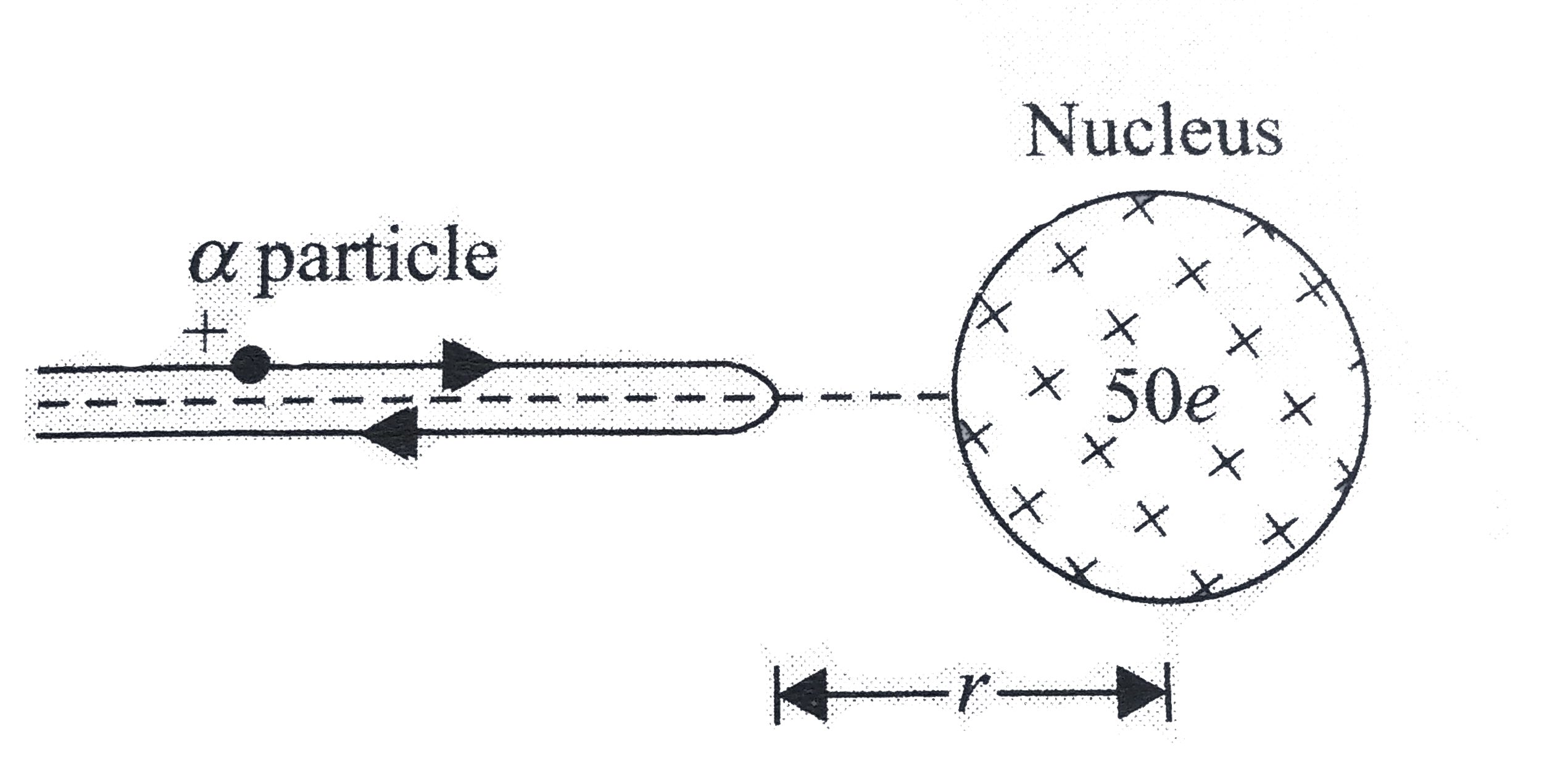An alpha particle with kinetic energy MeV happens, by chance,to be headed directly toward he nucleus of a neutral gold atom (fig). What is its distance of closest approach d (least center to center separation) to the nucleus? Assume that the atom remains stationary.
To find the distance of closest approach d for an alpha particle with kinetic energy Ki=5.30 MeV heading towards a gold nucleus, we can use the principle of conservation of energy. Here are the steps to solve the problem:
Step 1: Convert Kinetic Energy to Joules
The kinetic energy Ki is given in MeV. We need to convert it to joules using the conversion factor 1eV=1.6×10−19J.
Ki=5.30MeV=5.30×106eV=5.30×106×1.6×10−19J
Calculating this gives:
Ki=8.48×10−13J
Step 2: Identify Charges
An alpha particle consists of 2 protons and 2 neutrons, so it has a charge of +2e, where e=1.6×10−19C.
q1=2e=2×1.6×10−19=3.2×10−19C
The gold nucleus has 79 protons, giving it a charge of +79e.
q2=79e=79×1.6×10−19=1.264×10−17C
Step 3: Use Conservation of Energy
At the point of closest approach, all the kinetic energy of the alpha particle will have been converted into potential energy due to electrostatic repulsion. The potential energy U between two point charges is given by:
U=k⋅q1⋅q2d
where k is Coulomb's constant (k≈9×109N m2/C2).
Setting the initial kinetic energy equal to the potential energy at the closest approach:
Ki=U
Substituting the expressions we have:
8.48×10−13=(9×109)⋅(3.2×10−19)⋅(1.264×10−17)d
Step 4: Solve for d
Rearranging the equation to solve for d:
d=(9×109)⋅(3.2×10−19)⋅(1.264×10−17)8.48×10−13
Calculating the numerator:
(9×109)⋅(3.2×10−19)⋅(1.264×10−17)≈3.63×10−25
Now substituting this back into the equation for d:
d=3.63×10−258.48×10−13≈4.29×10−14m
Final Answer
Thus, the distance of closest approach d is approximately:
d≈4.29×10−14m
---
The kinetic energy Ki is given in MeV. We need to convert it to joules using the conversion factor 1eV=1.6×10−19J.
An alpha particle consists of 2 protons and 2 neutrons, so it has a charge of +2e, where e=1.6×10−19C.
At the point of closest approach, all the kinetic energy of the alpha particle will have been converted into potential energy due to electrostatic repulsion. The potential energy U between two point charges is given by:
Rearranging the equation to solve for d:
Thus, the distance of closest approach d is approximately:
Topper's Solved these Questions
- BOOK - RESNICK AND HALLIDAYCHAPTER - THE NUCLEUSEXERCISE - CHECKPOINT5videos
THE NUCLEUS
- BOOK - RESNICK AND HALLIDAYCHAPTER - THE NUCLEUSEXERCISE - PROBLEMS66videos
THE NUCLEUS
- BOOK - RESNICK AND HALLIDAYCHAPTER - THE KINETIC THEORY OF GASESEXERCISE - PRACTICE QUESTIONS72videos
THE KINETIC THEORY OF GASES
- BOOK - RESNICK AND HALLIDAYCHAPTER - UNITS AND MEASUREMENT EXERCISE - PRACTICE QUESTIONS (MATRIX-MATCH)11videos
UNITS AND MEASUREMENT
Similar Questions
An alpha particle having KE equal to 8.7MeV is projected towards the nucleus of copper with Z=29. Calculate its distance of closest approach.
View SolutionWhat is the distance of closest approach of an alpha particle to a silver nucleus is the kinetic energy of the alpha particle is 0.40 MeV.
View Solution
Knowledge Check
- Question 1 - Select One
A beam of beryllium nucleus (z = 4) of kinetic energy 5.3 MeV is headed towards the nucleus of gold atom (Z = 79). What is the distance of closest approach?
A10.32×10−14mB8.58×10−14mC3.56×10−14mD1.25×10−14m
A 5MeVα particle is projected towards a stationary nucleus of atomic number 40. Calculate distance of closest approach.
View SolutionAn alpha particle with kinetic energy 10MeV is heading toward a stationary tin nuclcus of atomic number 50. Calculate the distance of closest approach (Fig . 3.23).
 .View Solution
.View SolutionAn α-particle of kinetic energy 7.68 MeV is projected towards the nucleus of copper (Z=29). Calculate its distance of nearest approach.
View SolutionAn α-particle with kinetic energy K is heading towards a stationary nucleus of atomic number Z. Find the distance of the closest approach.
View SolutionWhat will be the distance of closest approach of a 5 MeV α-particle as it approaches a gold nucleus ? (Given atomic no of gold =79)
View SolutionCalculate the energy of an α-particle whose distance of closest approach with the gold nucleus is 29.5 fermi.
View SolutionDefine the distance of closest approach. An a particle of kinetic energy K is bombarded on a thin gold foil. The distance of the closest approach is r. What will be the distance of closest approach for an a particle of double the kinetic energy?
Or
Write two important of Rutherford nuclear model of the atom.View Solution

